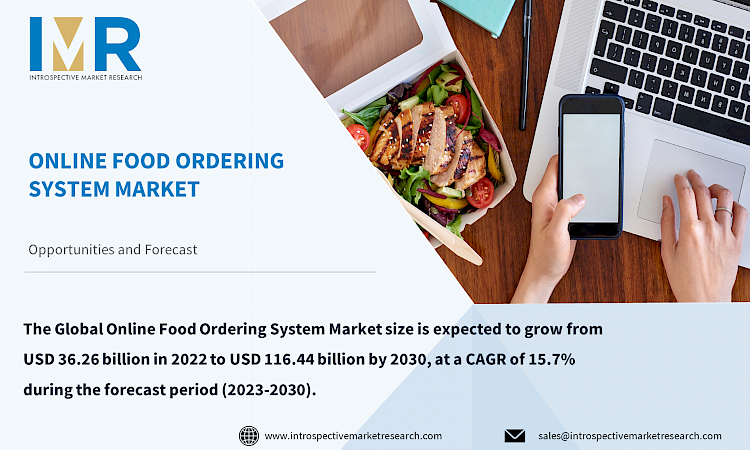Market Overview:
The Global Online Food Ordering System Market size is expected to grow from USD 36.26 billion in 2022 to USD 116.44 billion by 2030, at a CAGR of 15.7% during the forecast period (2023-2030).
Online food ordering is the process used by individuals to place food orders from another website or mobile application. Businesses can manage online orders for delivery or takeout placed by customers using an online food ordering system. Customers use search engines to locate a digital menu on a website or app, place their order, and then pay for it. Following an order being placed, restaurants that accept online food orders receive the order information and prepare the order for delivery or customer pickup. A complete sales channel for the restaurant is provided by an online ordering and delivery system. The restaurant gets the most benefit from this online ordering system they can use it as a tool for generating more profits and managing their restaurant in a better way.
Top Key Players Covered In The Online Food Ordering System Market:
- McDonalds (US)
- KFC (US)
- GrubHub (US)
- Swiggy (US)
- MEITUAN (China)
- Uber Eats (California)
- DoorDash (US) and other major players.
Market Dynamics and Factors:
Fast, easy, and comfortable modes of getting food are driving the Online Food Ordering System Market. Because it's a convenient way to have everything at their fingertips, customers prefer to order food through an online ordering system. For placing food orders, most people use their mobile phones or computers. Anyone with a smartphone can place an online food order with the eatery. Millennials are the most likely demographic to use this system and are the primary target market for this market. The system and vendors' quick, simple, and comfortable service are anticipated to drive significant market growth for online food ordering systems during the anticipated time frame.
Advancement in menu engineering helps systems to create a strong and convincing visual appearance of products is expected to grow Online Food Ordering Systems. Menu engineering is the practice of using menu psychology and restaurant menu design strategies to entice and motivate customers to spend more money on food. Customers who order food online typically do so based on how hungry they are, and the majority of the time they choose a product based solely on its alluring visual appeal rather than because it satisfies their hunger. Design advise from Menu Engineering can be used to create a menu that is highly persuasive and encourages customers to place additional orders.
Online Food Ordering System Market Report Highlight:
- By type, the delivery platforms segment is anticipated to lead the growth of the Online Food Ordering System market in the forecasted timeframe. The market for online food ordering systems is expanding as more people around the world use apps like Zomato, Uber Eats, Deliveroo, and Grubhub, among others, for food delivery.
- By application, the B2C segment is expected to have the highest share of the Online Food Ordering System market over the projected period. Through various platforms, such as restaurant-controlled, independent websites, food cooperatives, and delivery services, a large population uses this system.
- The Asia Pacific region is expected to have the highest share of the Online Food Ordering System market over the projected period. The market is expanding in this region because of growing consumer interest, the adoption of new technology, and improved technological understanding.
Key Industry Development:
- In July 2023, Uber Eats is raising the bar in personalized dining with the launch of its "Flavor Profile" system, a groundbreaking feature that empowers users to curate their taste preferences and receive tailor-made restaurant and dish recommendations. Harnessing the capabilities of this innovative system, customers can now define their flavor preferences, dietary restrictions, and cuisine interests, allowing the platform's advanced algorithms to craft bespoke suggestions.
- In January 2023, Door Dash has introduced its latest feature, "Dinner Genius," revolutionizing the meal delivery experience through the power of AI. Leveraging advanced algorithms, the platform now offers users personalized meal recommendations tailored to individual preferences, dietary restrictions, and past ordering history
Online Food Ordering System Market Segmentation:
By Type
- Restaurant-controlled
- Independent websites
- Food co-operatives
- Delivery platforms
By Application
- B2B
- B2C
- Others
For this report, Introspective Market Research has segmented the Online Food Ordering System Market based on region:
Regional Outlook (Revenue in USD Million; Volume in Units, 2023-2030)
North America
- The U.S.
- Canada
- Mexico
Eastern Europe
- Russia
- Bulgaria
- The Czech Republic
- Hungary
- Poland
- Romania
- Rest of Eastern Europe
Western Europe
- Germany
- UK
- France
- Netherlands
- Italy
- Spain
- Rest of Western Europe
Asia Pacific
- China
- India
- Japan
- Singapore
- Australia
- New-Zealand
- Rest of APAC
Middle East & Africa
- Saudi Arabia
- Qatar
- UAE
- Israel
- South Africa
- Turkey
South America
- Brazil
- Argentina
- Rest of SA






